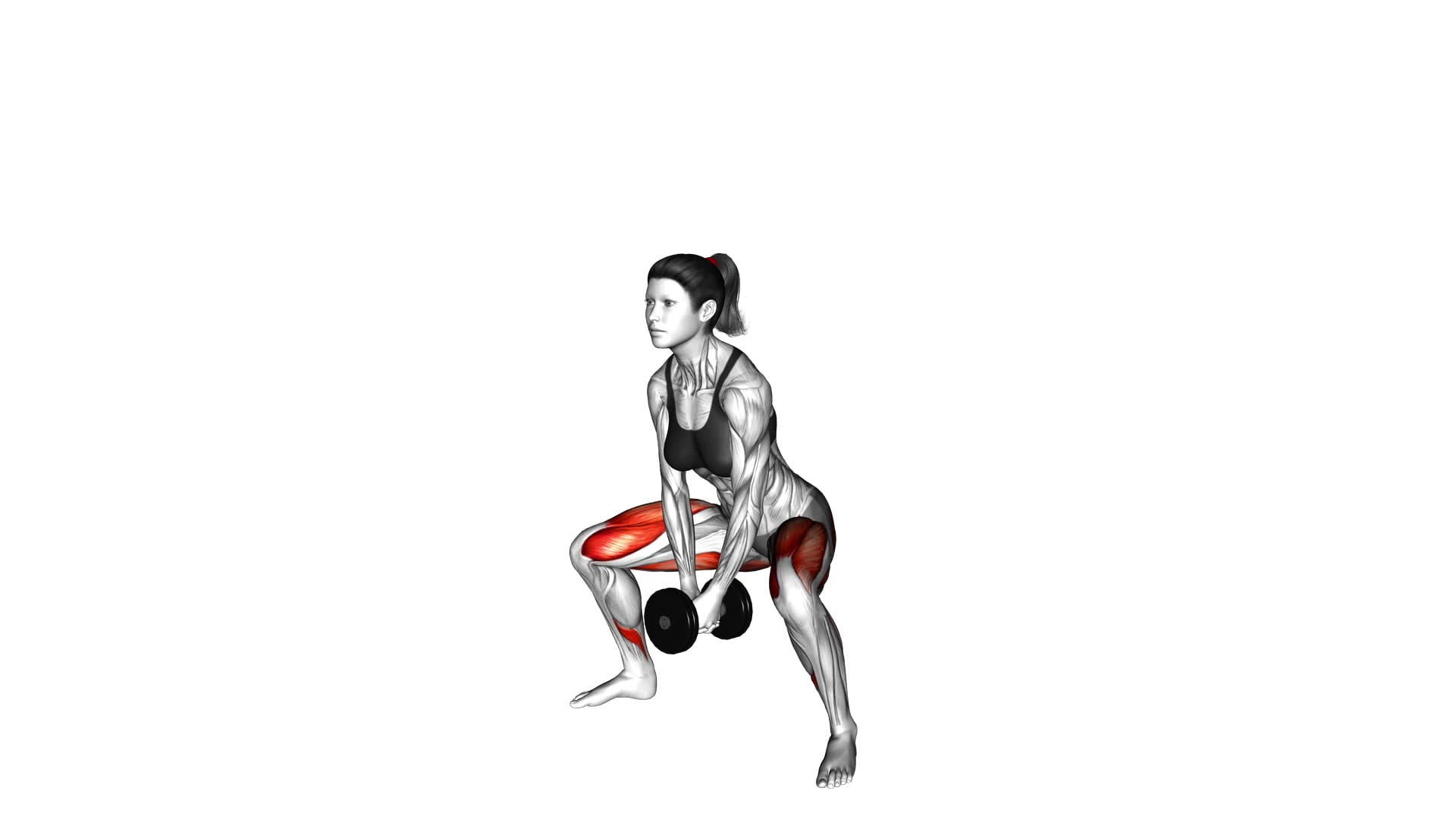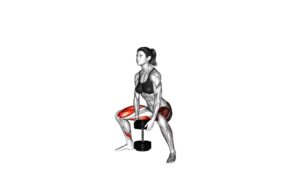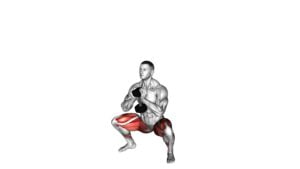Dumbbell Bar Grip Sumo Squat (female) – Video Exercise Guide & Tips

Are you looking for a powerful lower body exercise that targets your glutes and thighs? Look no further than the Dumbbell Bar Grip Sumo Squat.
Watch This Exercise Video
This dynamic exercise, specifically designed for females, engages multiple muscle groups and helps in building strength and toning your lower body.
In this video exercise guide, you'll learn the proper form and technique, variations, and common mistakes to avoid.
Get ready to maximize your results with these expert tips and get your squat on!
Key Takeaways
- Dumbbell Bar Grip Sumo Squat targets multiple muscle groups in the lower body
- It improves lower body strength, endurance, and stability
- It enhances core strength and stability
- Proper form and technique are crucial to maximize results and prevent injury
Benefits of Dumbbell Bar Grip Sumo Squat
The benefits of performing the Dumbbell Bar Grip Sumo Squat include targeting multiple muscle groups in the lower body, such as the quadriceps, hamstrings, glutes, and inner thighs. This exercise helps improve lower body strength, endurance, and stability. Additionally, it also improves core strength and stability by engaging the core muscles to maintain balance and control. This can lead to improved posture and reduced risk of lower back injuries.
To progress in the Dumbbell Bar Grip Sumo Squat, you can increase the weight of the dumbbells or perform more repetitions. Variations of the exercise, such as adding a pause at the bottom of the squat or using an unstable surface, can also be tried for added challenge.
Proper form and technique are crucial when performing the Dumbbell Bar Grip Sumo Squat to maximize its benefits.
Proper Form and Technique
To properly execute the Dumbbell Bar Grip Sumo Squat, position your feet in a wide stance while gripping the dumbbell bar. This exercise not only targets your lower body, but also engages your core and upper body muscles for a complete full-body workout.
Here are some important tips to ensure proper form and technique:
- Warm up: Before starting any exercise, it's crucial to warm up your muscles to prevent injury. Perform dynamic stretches or light cardio exercises to increase blood flow and loosen up your muscles.
- Proper breathing: Breathing plays a vital role in maintaining stability and providing energy during the squat. Inhale deeply as you lower your body, and exhale forcefully as you push back up. This helps to stabilize your core and provide the necessary oxygen to your muscles.
- Maintain a neutral spine: Keep your back straight and your chest lifted throughout the movement. Avoid rounding your shoulders or arching your lower back, as this can lead to strain or injury.
- Engage your glutes: As you lower into the squat, focus on pushing your hips back and down, while keeping your knees in line with your toes. This helps to activate your glutes and hamstrings, maximizing the effectiveness of the exercise.
Variations and Modifications
Try incorporating different variations and modifications into your Dumbbell Bar Grip Sumo Squat routine to add variety and challenge to your workout. There are several alternative equipment options you can use to target specific muscle groups and intensify your squats.
One variation is to use a kettlebell instead of dumbbells. Hold the kettlebell with both hands in front of your chest, and perform the sumo squat in the same way. This variation will engage your core and upper body more.
Another option is to use a resistance band around your thighs. This will increase the resistance and activate your glutes and outer thighs even more.
If you want to focus on your quadriceps, you can try performing the sumo squat on a Smith machine or using a barbell. This will allow you to lift heavier weights and challenge your lower body strength.
Finally, you can also try adding a jump at the top of each squat to incorporate plyometric movements and increase the intensity of your workout.
Common Mistakes to Avoid
To ensure proper form and maximize the effectiveness of your Dumbbell Bar Grip Sumo Squat, it's important to be aware of common mistakes to avoid. Here are some tips for proper execution:
- Incorrect foot placement: Avoid placing your feet too close together or too far apart. Your feet should be wider than shoulder-width apart, with toes pointing slightly outward.
- Rounding the back: Keep your back straight and upright throughout the movement. Avoid rounding your back, as it can lead to strain and injury.
- Not going deep enough: Make sure to squat down until your thighs are parallel to the ground. Going too shallow can limit the engagement of your glutes and hamstrings.
- Lifting heels off the ground: Keep your heels firmly planted on the ground throughout the exercise. Lifting your heels can put excessive pressure on your knees.
By avoiding these common mistakes, you can perform the Dumbbell Bar Grip Sumo Squat with proper form and reduce the risk of injury.
Now, let's move on to the next section to learn some tips for maximizing your results.
Tips for Maximizing Results
To maximize your results, focus on incorporating these tips into your Dumbbell Bar Grip Sumo Squat routine.
One key tip is to maximize the intensity of your squats. This can be done by increasing the weight of the dumbbells or the number of repetitions you perform. By challenging your muscles with heavier weights or more reps, you'll stimulate greater muscle growth and strength gains.
Another tip is to incorporate dumbbell variations into your Sumo Squat routine. This will help target different muscle groups and add variety to your workout. Some examples of dumbbell variations include goblet squats, front squats, or overhead squats. By switching up the dumbbell exercises, you can prevent muscle adaptation and keep your progress on track.
Additionally, it's important to maintain proper form throughout the exercise. Keep your back straight, chest lifted, and knees aligned with your toes. Engage your core and squeeze your glutes as you rise from the squat position. This will ensure that you're targeting the correct muscles and minimizing the risk of injury.
Frequently Asked Questions
What Are Some Alternative Exercises That Target Similar Muscle Groups as the Dumbbell Bar Grip Sumo Squat?
Looking for alternative exercises that target similar muscle groups as the dumbbell bar grip sumo squat? Well, there are a few options you can try.
One great alternative is the goblet squat, which also works your quads, hamstrings, and glutes.
Another option is the Bulgarian split squat, which targets your legs and core.
If you're looking to switch things up, give the dumbbell step-up a try.
These exercises offer similar benefits to the dumbbell bar grip sumo squat and will help you build strength and tone your lower body.
Can the Dumbbell Bar Grip Sumo Squat Be Performed Using a Kettlebell Instead of a Dumbbell?
Using a kettlebell instead of a dumbbell for the sumo squat can be a great alternative. Kettlebells provide a different grip and weight distribution, which can challenge your muscles in a unique way.
The sumo squat with a kettlebell can engage your glutes, quads, and inner thighs effectively. It also helps improve balance and core stability.
How Often Should I Incorporate the Dumbbell Bar Grip Sumo Squat Into My Workout Routine?
To effectively incorporate the dumbbell bar grip sumo squat into your workout routine, it's important to have a structured plan.
Start by performing the exercise 2-3 times a week, allowing for rest days in between. As you progress, you can gradually increase the frequency to 4-5 times a week.
This will help you build strength in your lower body, improve stability, and enhance overall muscle tone. Remember to start with lighter weights and focus on proper form to maximize the benefits.
Is It Necessary to Warm up Before Performing the Dumbbell Bar Grip Sumo Squat?
Before performing the dumbbell bar grip sumo squat, it's necessary to warm up. Warming up has several benefits, such as increasing blood flow to your muscles and joints, improving flexibility, and reducing the risk of injury.
To perform the sumo squat with proper form and technique, start by standing with your feet wider than shoulder-width apart, toes turned out slightly. Keep your chest up, back straight, and lower down into a squat position, making sure to push through your heels as you rise back up.
Can the Dumbbell Bar Grip Sumo Squat Help Improve Flexibility in Addition to Strength?
Yes, the dumbbell bar grip sumo squat can indeed help improve flexibility in addition to strength. By performing this exercise, you're engaging multiple muscle groups, including the glutes, quads, hamstrings, and inner thighs.
This movement requires a wide stance and a deep squat, which stretches the muscles and increases their flexibility.
Incorporating the dumbbell bar grip sumo squat into your workout routine can provide both strength and flexibility benefits for your lower body.
Conclusion
In conclusion, the dumbbell bar grip sumo squat is a highly effective exercise for strengthening and toning the lower body muscles, particularly the quads, glutes, and hamstrings.
By maintaining proper form and technique, and avoiding common mistakes, you can maximize your results and achieve your fitness goals.
Remember to start with lighter weights and gradually increase as you build strength.
Incorporating this exercise into your workout routine can help you achieve a strong and sculpted physique.

Author
Years ago, the spark of my life’s passion ignited in my mind the moment I stepped into the local gym for the first time. The inaugural bead of perspiration, the initial endeavor, the very first surge of endorphins, and a sense of pride that washed over me post-workout marked the beginning of my deep-seated interest in strength sports, fitness, and sports nutrition. This very curiosity blossomed rapidly into a profound fascination, propelling me to earn a Master’s degree in Physical Education from the Academy of Physical Education in Krakow, followed by a Sports Manager diploma from the Jagiellonian University. My journey of growth led me to gain more specialized qualifications, such as being a certified personal trainer with a focus on sports dietetics, a lifeguard, and an instructor for wellness and corrective gymnastics. Theoretical knowledge paired seamlessly with practical experience, reinforcing my belief that the transformation of individuals under my guidance was also a reflection of my personal growth. This belief holds true even today. Each day, I strive to push the boundaries and explore new realms. These realms gently elevate me to greater heights. The unique combination of passion for my field and the continuous quest for growth fuels my drive to break new ground.







